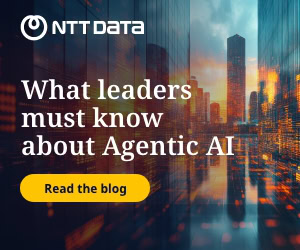A unified AI vision serves as the Guiding Principle for enterprise-wide AI adoption, ensuring that all departments work toward common strategic objectives. Without this alignment, organisations risk fragmented investments, duplicated efforts, and missed opportunities for transformation.
A cohesive vision enables CIOs to prioritise initiatives that deliver measurable business value while fostering cross-functional collaboration between IT, business units, and leadership. It also facilitates better resource allocation, accelerates time-to-value, and builds organisational consensus around AI's role in driving competitive advantage and operational excellence.
Artificial intelligence (AI) has emerged as a transformative force across industries, promising enhanced productivity, innovative business models, and improved customer experiences.
However, as recent data from the latest ServiceNow Enterprise AI Maturity Index reveals, many organisations in the Asia Pacific (APAC) region face a troubling paradox: escalating enthusiasm for AI at the executive level contrasts sharply with strategic misalignment, governance gaps, and fragmented AI deployments.
This disconnect is hindering the capture of real value and increasing operational and cultural risks across enterprises.
In this context, CK Tan, APJ innovation officer at ServiceNow, emphasises the essentiality of a unified AI vision, asserting that, "You can't steer what you can't see. Enterprises are pushing forward with AI, but without a unified vision or clear line of sight across the business, they're essentially flying blind."
Enthusiasm tempered by challenges.
The ServiceNow study, conducted in mid-2025, highlights a critical trend across key APAC markets: despite greater C-suite optimism about AI, many organisations are paradoxically reducing their relative AI budgets.
This budget contraction signals deeper issues around strategic clarity and ROI realisation.
More strikingly, only 39% of enterprises across the four examined markets reported having a shared, clear AI vision aligned with business transformation goals.
Tan underscores this risk: "Most organisations are scaling AI without a clear vision or governance, which limits returns despite growing enthusiasm."
Fragmented AI deployments create operational risks, resulting in duplicated effort and inconsistent experiences, as well as cultural risks, including employee anxieties about job security and ethical concerns such as data misuse.
Tan emphasises, "Leading with transparency and putting people at the centre of AI is essential to building trust and unlocking long-term value."
Why a unified AI vision
A unified AI vision is more than a strategic nicety — it is the cornerstone for intelligent governance, risk mitigation, and value maximisation. Gartner has long emphasised that "AI governance frameworks are fundamental to managing risk, compliance, and ethical use while driving innovation."
Similarly, Forrester stresses that "business leaders must align AI investments with clear business objectives supported by enterprise-wide collaboration for scalable impact."
Tan's experience with enterprises adopting AI resonates with these recommendations. He notes the paradox that despite AI's potential to transform, many leaders still view it narrowly, focusing on incremental gains rather than step-change innovation:
"AI is not just about augmenting tasks or cutting costs. It's about transforming the entire business model to work better, faster, and more cost-effectively while expanding the ecosystem. IKEA's example is illuminating — rather than replacing level one service staff with chatbots, they redeployed them as interior designers, creating new business lines."
Tan's observation that AI enables "doing more with less" without eliminating jobs outright highlights the need for a vision that integrates AI into workforce reskilling and job reimagination. This human-AI partnership framework can demystify AI's impact, build workforce trust, and prevent reactionary fears.
Pillars to tackle AI fragmentation
One of the study's key findings is pervasive governance deficiency: over half of enterprises in Singapore (56%), Australia (57%), and India (51%) lack formal AI governance frameworks. This vacuum causes fragmented deployments managed by multiple task forces working in isolation, which Tan warns, "introduces risk when governance structures are missing."
Without robust governance, organisations expose themselves to operational disruption, compliance breaches, and model bias, threatening the organisation's integrity and stakeholder trust.
To counter 'shadow AI'—where individual departments independently deploy AI solutions—CIOs must foster cross-functional collaboration. This includes establishing unified policies, responsible AI use frameworks, and shared metrics aligned with business outcomes.
Gartner echoes this approach, advocating "AI Centre of Excellence" models that provide oversight, knowledge sharing, and standards enforcement.
Tan outlines a pragmatic approach, combining stringent validation ("we got to validate the sources again..."), fostering original thinking, and enforcing cybersecurity protocols against recent threats, such as model hijacking.
He emphasises that: "It takes effort, but enterprises must build these frameworks to translate regulator guidelines into practical organisational controls that support AI's responsible use."
Rethinking workflows to extract actual AI value
Beyond governance, AI can unlock value only if organisations rethink workflows rather than merely layering AI onto legacy processes.
The ServiceNow study shows that companies reimagining workflows are three times more likely to report improvements in efficiency and employee experience. This is critical because "solution sprawl" — the practice of accumulating multiple single-purpose AI tools without integration — undermines scalability and adds complexity.
As Tan puts it: "Organisations must treat AI as a strategic lever for end-to-end transformation — not a bolt-on enhancement — by reworking processes to leverage AI's capabilities deeply."
Building and sustaining AI vision into 2026 and beyond
Looking ahead, Tan advises CIOs and technology leaders to anchor their efforts in a cohesive, enterprise-wide AI vision that aligns with their long-term business strategy:

"My advice is simple — build a unified AI vision that connects technology, people, and business outcomes. Foster collaboration across functions and put governance and ethics at the heart. It's only through such integration that AI will help organisations work better, faster, and smarter. Without it, the risk far outweighs the reward." C K Tan
One more time
The promise of AI to revolutionise business in APAC is clear yet unlocking this potential demands more than talent or technology investment alone. It requires an overarching, unified AI vision embraced by the entire organisation—from the C-suite to frontline employees—backed by robust governance and a commitment to innovation that redefines workflows and business models.
As Tan put it: "Without a shared AI strategy and comprehensive governance, enterprises risk operating in silos, flying blind, and missing the full potential of AI's power."
As organisations prepare for 2026 and beyond, embracing a unified AI vision is not merely advisable but critical for sustained success in a rapidly evolving digital landscape.
Click on the PodChats player to hear Tan's perspective on the critical need for a unified AI vision.
- What does a "unified AI vision" mean in practice, and why is it critical for CIOs to champion this now?
- How can organisations in Asia align AI investments with core business strategy and measurable KPIs to demonstrate clear ROI?
- What proven metrics and maturity models can leaders use to track progress toward enterprise-wide AI adoption and competitive advantage?
- How should the CIO and CFO jointly measure, report, and justify the business value of AI investments to stakeholders?
- How can CIOs foster cross-functional collaboration to break down silos and prevent AI solution sprawl?
- What governance frameworks are currently in place to manage AI risks, ensure accountability, and maintain regulatory compliance? What gaps remain, especially in the APJ region?
- The adoption of AI brings cultural and operational disruptions. What change management strategies should organisations deploy to build workforce trust and accelerate adoption?
- AI risks exacerbating technical debt if not integrated thoughtfully. Based on early 2025 lessons, how can CIOs embed AI into legacy workflows without creating long-term liabilities?
- How should CIOs articulate the long-term AI tech debt strategy—and its financial implications—to the CFO and Board?
- Into 2026, what is your advice for CIOs and other technology leaders as they build and sustain a unified AI vision across their organisations?





